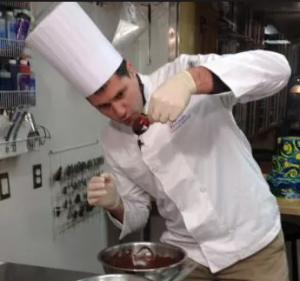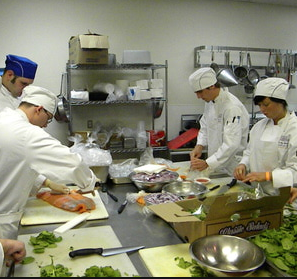Culinary midterms arrived this week, darkening the mood of the students, just in time for Halloween. To say that some of my students were not prepared is an understatement and should rightfully be attributed to my lack of delivering a real-world wake-up call these first few weeks of class. We tend to ease them into each quarter whether it’s their first or their last, which for an Advanced Techniques student is always a risk.
These are kids that are a quarter away from working in a real kitchen, not one that we create and control for them. Advanced Techniques is designed to bring them through a series of stations where they are forced to create a plate from available ingredients, a type of “training wheels” mystery basket.

It simulates a typical day in a kitchen, with recipe and menu design, prep, service, and presentation. What we can’t really produce is real pressure, the adrenaline rush that kicks in when the line is busy, and you may be behind. So, the students sometimes plod through their lab with little more than a hiccup or two until there is a brief flurry of fear as they bring their plates to me for critiques. Even then their calm seems to return, and their nonchalance resurfaces.
That all ends with the arrival of midterm, and finals week. Two weeks out of ten when some seem paralyzed by what lies before them. In the case of midterms, two plates, both the same, prepped and presented on two separate days. It would seem to be a cakewalk for most, but with the added expectation of classic knife cuts, and the emphasis of every little detail being tight, these two days become a study in concentration and provide a glimpse into each student’s coping mechanism.
This part of a culinary education is rarely mentioned either in recruiting pitches or in class. We speak of the pressures of the business to every prospective student, we warn them about burning the candle at both ends when they miss a few days, and we may suggest that this career may not be for them if they start losing interest in even the most engaging aspects of lab. But applying real pressure in the controlled atmosphere of a culinary lab is a rare feat.

I was less than stellar in my practical midterms and finals. I would cruise through my labs and lectures and come to a grinding halt when faced with the structure of an exam to measure my progress. When I became a culinary instructor, I was mindful of how structured I wanted my own practical’s but there are very few handbooks on the how to’s. I wanted a sense of urgency, the pressure you feel on a busy prep day rolling into a monster service. I wanted to test decision making, problem-solving and innovation all in a two-hour exam. I felt that if all those areas were covered then the true skill set would be very easy to assess.
I was partially correct, as I failed to take into account the very things that had tripped me up in my exams. It’s hard to grade innovation when the student is working offset recipes, hard to gauge innovation when all the ingredients are provided. So, to raise the stakes to a somewhat uncomfortable level, one in which the student had to actively solve problems, I went to a mystery basket format and timed windows of presentation. These techniques are active, forcing the student to formulate flavor combinations and plan prep lists for items that may or may not be there. We limit their time, giving them presentation windows that loom like a bullseye over their practical exam. These steps produce an active, experiential exam which hopefully addresses some of the issues that my static exams of the past created. It also tends to give the student and the lab a jolt of (albeit nervous), energy.
The results from these types of practical exams are pretty clear. A culinary student’s main issue and one that employers have commented on every quarter is their lack of urgency. Given a three-hour lab to work with they use every minute to produce something, rarely realizing that the rest of the time they are drifting through their day. That will get you nowhere fast in a busy restaurant.

Working with a purpose is not some old-fashioned, turn of the century motto, but a positive trait of every successful cook. It not only gets the work done, it allows the cook to take on more work and responsibility, thereby opening the door for greater opportunity and pay. The kitchen may be a dictatorship, but the career is democratic in nature. It really does reward hard work, repetitive skills and in the process, the innovation that comes from the pressures of creating food for complete strangers, every night, night after night. A student’s ability to realize that early, and work hard every quarter to reach that goal might be the single, most important point in their education.
And once you’ve reached that conclusion, it’s just the next step in your development. Instead of the instructor creating the simulated experience in lab, it’s the student’s obligation to seek out that same challenge in their workplace. It’s much easier to assimilate into a busy environment when you’ve had plenty of practice. You can’t practice if you don’t approach every day with a sense of urgency, a desire to learn as much as you can and then practice it.
Desire is the one trait that can’t be taught, and if you have the desire to be the best cook you could possibly be, then your success as a chef will be assured.

John Foster is an executive chef who heads the culinary program at Sullivan University’s Lexington campus. A New York native, Foster has been active in the Lexington culinary scene and a promoter of local and seasonal foods for more than 20 years. The French Culinary Institute-trained chef has been the executive chef of his former restaurant, Harvest, and now his Chevy Chase eatery, The Sage Rabbit.
To read more from Chef John Foster, including his recipes, click here.
























